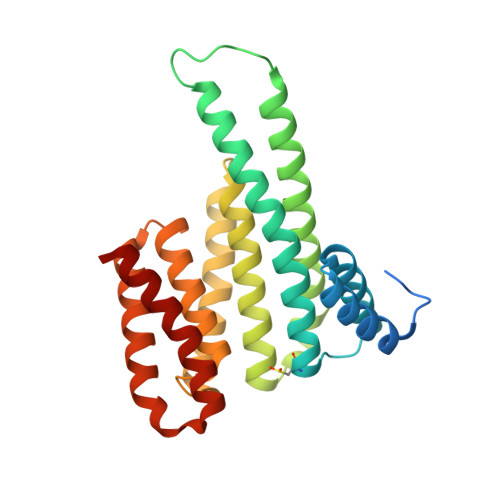Characterizing the protein-protein interaction between MDM2 and 14-3-3 sigma ; proof of concept for small molecule stabilization.
Ward, J.A., Romartinez-Alonso, B., Kay, D.F., Bellamy-Carter, J., Thurairajah, B., Basran, J., Kwon, H., Leney, A.C., Macip, S., Roversi, P., Muskett, F.W., Doveston, R.G.(2024) J Biological Chem 300: 105651-105651
- PubMed: 38237679
- DOI: https://doi.org/10.1016/j.jbc.2024.105651
- Primary Citation of Related Structures:
8P0D - PubMed Abstract:
Mouse Double Minute 2 (MDM2) is a key negative regulator of the tumor suppressor protein p53. MDM2 overexpression occurs in many types of cancer and results in the suppression of WT p53. The 14-3-3 family of adaptor proteins are known to bind MDM2 and the 14-3-3σ isoform controls MDM2 cellular localization and stability to inhibit its activity. Therefore, small molecule stabilization of the 14-3-3σ/MDM2 protein-protein interaction (PPI) is a potential therapeutic strategy for the treatment of cancer. Here, we provide a detailed biophysical and structural characterization of the phosphorylation-dependent interaction between 14-3-3σ and peptides that mimic the 14-3-3 binding motifs within MDM2. The data show that di-phosphorylation of MDM2 at S166 and S186 is essential for high affinity 14-3-3 binding and that the binary complex formed involves one MDM2 di-phosphorylated peptide bound to a dimer of 14-3-3σ. However, the two phosphorylation sites do not simultaneously interact so as to bridge the 14-3-3 dimer in a 'multivalent' fashion. Instead, the two phosphorylated MDM2 motifs 'rock' between the two binding grooves of the dimer, which is unusual in the context of 14-3-3 proteins. In addition, we show that the 14-3-3σ-MDM2 interaction is amenable to small molecule stabilization. The natural product fusicoccin A forms a ternary complex with a 14-3-3σ dimer and an MDM2 di-phosphorylated peptide resulting in the stabilization of the 14-3-3σ/MDM2 PPI. This work serves as a proof-of-concept of the drugability of the 14-3-3/MDM2 PPI and paves the way toward the development of more selective and efficacious small molecule stabilizers.
Organizational Affiliation:
Leicester Institute for Structural and Chemical Biology, University of Leicester, Leicester, UK; Mechanisms of Cancer and Aging Laboratory, Department of Molecular and Cell Biology, University of Leicester, Leicester, UK.

























